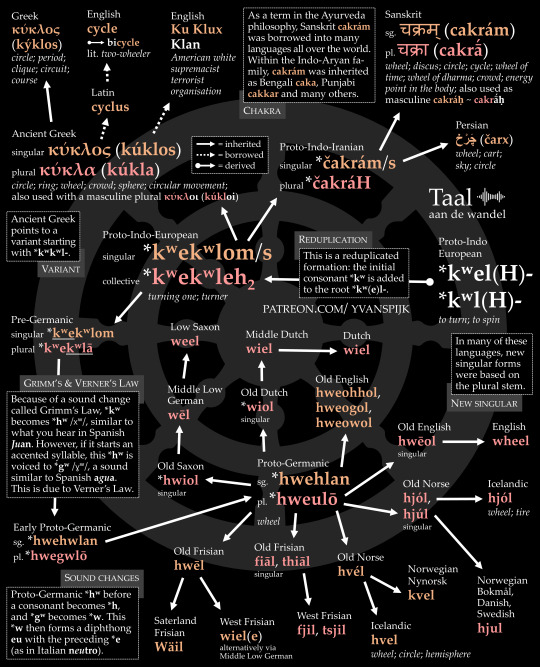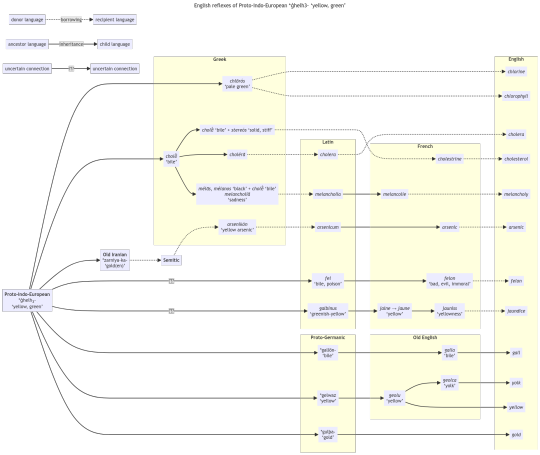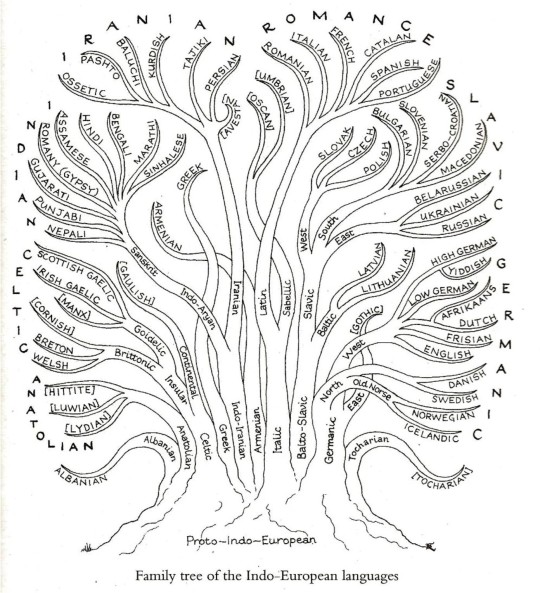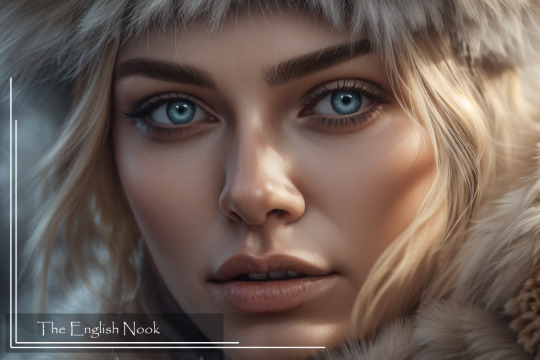#proto indo Iranian
Explore tagged Tumblr posts
Text
white
safed: Persian, Urdu/Hindi, Tajik
shofed: Bengali
saphed: Marathi
sapheda: Odia
safaid: Punjabi
spin: Pashto
spî: Northern and Central Kurdish
spîd: Southern Kurdish
išpéru: Khowar
séta: Javanese (literary)
śvet: Hindi, Gujarati
śvēta: Kannada
shada: Bengali
27 notes
·
View notes
Text

Wheel, cycle, chakra
The words wheel, cycle, and chakra are all distantly related. Via Germanic, Ancient Greek and Sanskrit, they can be traced back to Proto-Indo-European, the reconstructed common ancestor of these languages. Sound changes made these words grow apart. These words are also related to bicycle and Ku Klux (Klan). Click the graphic for more.
#historical linguistics#linguistics#language#etymology#english#latin#dutch#lingblr#frisian#low saxon#icelandic#norwegian#danish#swedish#sanskrit#persian#ancient greek#proto-indo-european#proto-germanic#proto-indo-iranian
93 notes
·
View notes
Text
Finnish words by unusual language of origin
*note: this does not list all the languages that the word was borrowed from, only the oldest known origin of it
*also: if you've never seen a word on this list, please don't doxx me. These are all real words. I don't spread misinformation. Why do I still need to put this in my posts
Job: Ammatti (from proto-celtic *ambaxtos) Fun Fact: this is the same root that forms the english word “Ambassador”!
Wagon: Kärry (from proto-celtic *karros) Fun Fact: This is the root that forms the English word “Car”!
Poem: Runo (from proto-celtic *rūnā) Fun Fact: This is the root that forms the English word “Rune”!
Hikikomori: Hikky (from Japanese hikikomori 引き籠もり)
Clam: Simpukka (from Mandarin zhēnzhū 珍珠)
Goods: Tavara (from proto-turkic *tabar) Fun Fact: words descended from this root can be found as far as China and Siberia!
Dungeon, jail: Tyrmä (from proto-turkic *türmä) Fun Fact: This toot extends to Azerbaijan and even Yiddish!
Rauma (city name) (from proto germanic *straumaz meaning stream)
Cherry: Kirsikka (from ancient creek kerasós κερασός which might also have older forms) Fun Fact: this word is widespread, even appearing in Arabic.
God: Jumala (possibly from proto-indo-iranian) Fun Fact: This word could be related to Sanskrit dyumna द्युम्न if it is from proto-indo-iranian

#finnish#langblr#langblog#language#study blog#suomen kieli#finnish language#finnish langblr#word roots#proto-celtic#proto-turkic#germanic#celtic#indo-iranian
102 notes
·
View notes
Text
Words you didn’t know are related: gold, yellow, cholera, arsenic, yolk, and more!
The Proto-Indo-European language (the hypothesized original ancestor language of most modern languages in Europe and South Asia, hereafter abbreviated “PIE”) had a root *ǵʰelh₃- ‘yellow, green’. Aside: How can this word refer to both ‘yellow’ and ‘green’? Historically, color terms in the world’s languages referred to a broader range of colors than they do today, and focused more on the texture…

View On WordPress
#English#etymology#French#Greek#historical linguistics#historical reconstruction#Indo-European#Iranian#Latin#Latvian#Old English#Proto-Indo-European#Russian#Semitic#Slavic
53 notes
·
View notes
Text

#language#languages#family tree#family tree of languages#proto indo european#where language comes from#know your roots#anatolian#celtic#romance#germanic#slavic#indian#iranian#did you know#how cool is that#language is fun#language is beautiful#spoken word#written words#evolution of language#something cool#linguistics#writers on tumblr#writerscommunity#where we came from#i just think they're neat
14 notes
·
View notes
Text
Proto-Indo-European Language Family
Unraveling the Threads of Proto-Indo-European The Proto-Indo-European (PIE) language serves as the theoretical common ancestor of a vast array of languages spoken across Europe and parts of Asia today. While there are no direct written records of PIE, linguists have pieced together its existence and characteristics through comparative analysis of its descendant languages. Origins and…

View On WordPress
#Balto-Slavic languages#Celtic languages#Cultural Exchange#Cultural legacy#english-learning#Germanic languages#Historical linguistics#Indo-European languages#Indo-Iranian languages#Language evolution#Language Origins#language-learning#linguistic diversity#Proto-Indo-European
0 notes
Text
*H₂eryo-men
* H₂eryo-men is the fictitious name for a deity in Proto-Indo-European religion, linked to healing, the formation of marriage, and the construction and maintenance of roads or paths. The deity is believed to be responsible for community well-being.
The noun *h₃eryos, which means "a member of one's own group" or "someone belonging to the community," as opposed to a foreigner, is the source of the term *h₂eryo-men. Further derivatives of this root are the Indo-Iranian *árya, "noble, hospitable", and the Celtic *aryo-, "free man" (most notably as aire, "noble, chief" in Old Irish, and as arios, "free man, lord" in Gaulish).
Xaryomen is another spelling of his name.
The Vedic god Aryaman, who is mentioned in the Vedas for his ties to social and matrimonial ties, is one of the descendant deities in later traditions. Similarly, the Iranian god Airyaman, mentioned in the Gāthās, is invoked in prayers to ward off illness, sorcery, and evil. He represents the larger tribal community or alliance. The legend that tells the story of Ireland's founding names the hero Érimón as the first king of the Milesians, the mythical people who inhabited the island after it was taken from the Tuatha Dé Danann. This legend also addresses the roles that *h₂eryo-men played in marriage by giving wives to the Cruithnig, the mythical Celtic Britions or Picts. The influence of the deity is further demonstrated by the Gaulish name Ariomanus, which means "lord-spirited" and was frequently used by Germanic chiefs.
#Gaulish#free man#Proto-Indo-European#Indo-Iranian#Celtic#Old Irish#Vedic#Iranian#Gāthās#Érimón#Milesians#Tuatha Dé Danann#Celtic Britons#Picts#Germanic#community#name#meaning#noble#mythical#marital#man#god#druidicentropy
1 note
·
View note
Text

I'm always at least slightly irritated and sometimes get full on pissed off that white supremacist jackasses have infiltrated and changed the culture within a lot of my interests. Like, I'm interested in ancient Rome, and the US Civil War, and proto-Indo-Europeans, and Norse mythology, and Greek mythology, and wargaming, and heavy metal, and just... can you all just *fuck off* from my interests?
I love reading about the largest, longest-lasting empire in western history, and how it impacted all the cultures that came after it, but it was an EMPIRE and therefore HORRIBLE and unlike so many I actually understand that? It's just super interesting!
I am endlessly fascinated by the Civil War, particularly the cultural struggles in the North to get people lined up behind abolition before and during the war, and the heroism of people like Harriet Tubman and Sojourner Truth, but yes, I'm a war nerd, I ALSO get very interested in the battles, particularly the ones where large events hinged on seemingly small actions- Lee's scouts losing his orders leading to Antietam, Chamberlain's bayonet charge at Gettysburg, the countless blunders by generals on both sides leading to ever greater loss of life than the world had previously seen outside of the Napoleonic Wars, a foreshadowing of the mechanized slaughter war was to become.
That there was an influential culture or family of cultures whose linguistic imprint remains detectable to this very day in languages as diverse as Sanskrit, Latin, and Old Norse, is FASCINATING. Of course, ever since the Nazis decided that said culture was 'Aryan' the whole topic has become basically a minefield where you have to pick through mountains of bullshit for the honest linguistic archaeology. It wasn't 'Aryan' in the sense of some mythical super-white people and it wasn't even Aryan in the sense of the pre-Vedic Iranian/Indian peoples, it was older than that. Harrumph.
For a person who grew up reading Greek mythology, who finds it referenced in everything from Shakespeare to Modernist classics, of course it's interesting. And Norse mythology is so different from it! The gods are no less flawed and human, but in such a different way! The stories are often HILARIOUS. But of course white nationalist idiots have co-opted both as part of their grand imagined past and 'rightful' culture. Bad news for both- there are thousands of years of massive upheaval, cultural and demographic change in both Magna Graecia and Scandanavia, and NONE of you are anything like your 'ancestors.' Not that that's even a bad thing! Let people, societies, and cultures evolve! The past is interesting but it's not sacred! Fuck!
Wargaming... look even I admit this one is sus on the surface of it. It's bad enough when you're playing a fantasy game with fantasy factions, and god help you if you're into historicals, you are GOING to run into someone's Confederates or Nazis or the like. But the very concept can't help but inherently glorify war, which, you know, to quote George C. Scott as Patton 'god help me, I love it so,' because there's very little if anything glorious about mass murder for dubious goals but the heights of emotion and performance people reach is compelling, okay? It's melodrama with dice. Nobody actually gets hurt. This is a much healthier outlet for my weird fixation on quite possibly the Worst Thing that Humans Do than joining the army or (more likely in my case) an intelligence service. would have been. I was given a head for tactics and analysis and a heart for the drums of war, and I channeled it into friendly games with other nerds. I'm proud of me for this one. Fucking fascists can go die.
There's nothing inherently fascist about metal, though the blasting drums definitely evoke the same primal intensity as war drums or the like. But like punk, it became kind of a counter-culture, and when the main culture was not as openly fascistic, that drew in a lot of fash. Anarchists and commies and just plain weirdos, too, but the fash are there and if you don't kick them right the fuck out immediately they pollute the whole scene. So I'm always gratified to hear Rammstein singing things like 'my heart beats Left' to tell the nazis to fuck right off. At least I'm not into Black Metal, that scene is far far far worse than my beloved Power Metal nerd shit.
Anyway yeah as the initial reaction image indicates I do periodically take stock of why I'm interested in so many of the same things as goddamned fascists, interrogating my own assumptions and thought processes. That's healthy, we all gotta be vigilant we don't get sucked into something vile. But for the most part, I hope you'll agree if you read this far, I seem to at least enjoy similar things for very different reasons than the goddamn fash. But hey, if you read this and spotted something sus, and you're comfortable doing so, by all means send me a reply or a message (on anon if you prefer) letting me know what that is. Not as a callout, not as a game of moral one-upsmanship, but as a comrade looking out for another comrade.
86 notes
·
View notes
Text
The other day, I learned (according to Wikipedia)
According to researchers at Durham University and the Universidade Nova de Lisboa, the tale type (AT 328, The Boy Steals Ogre's Treasure) to which the Jack story belongs may have had a Proto-Indo-European language (PIE) origin (the same tale also has Proto-Indo-Iranian variants),[10] and so some think that the story would have originated millennia ago (4500 BC to 2500 BC).[7]
‼‼‼
66 notes
·
View notes
Text

Starkey comics: I've made a giant tree of Indo-European languages! 🌳🌸
Actually this was just intended a template with which I plan to make a bunch of images about related words in these languages, so stay tuned for that. And I'll probably put a HD version of this image on my site soon too.
This image shows 64 living Indo-European languages (around the outside), as well as many dead and extinct languages.
Moving into the image from the outside we travel back in time, until we reach the core of the image, wherein lies Proto-Indo-European. PIE was spoken somewhere around the border of Europe and Asia, and diverged into the 10 inner Proto languages shown here 4500+ years ago.
There are about 380 Indo-European languages missing from this image, although I've tried to pick representatives from as many branches as possible. The Indo-Iranian branch is the largest, actually accounting for around 2 thirds of Indo-European languages.
-⭐🗝️
138 notes
·
View notes
Text
“Daryun.”
“What?”
“Remember when I said there was a gap in the flow of the word mardan?”
“You mean, that one time you squatted in front of a scroll pulling at your hair many years ago?”
“Rude! Anyways— I think I may have found the piece to bridge that gap.”
“Oh?”
“Writings and tales in Old Parsian always seemed to misuse the word— everything seemed too saturated with knights and warriors, even in places they did not belong. It's clear that it must've meant something else. Something must've shifted. But I did not know what. The old meaning of the word. The reason it shifted. I could not understand. But meeting this clan, the Mardi— and hearing their stories, I finally have the answer.”
“What is the answer you have found?”
“Simply put, it's a misunderstanding. The Mardi people were indispensable to the Hero King's army, the key to Zahhak's defeat. I mean, you've seen it yourself— how that Khazan fellow tore through the battlefield. Imagine what an entire army of those can do. With magics that the current Mardi have lost, no less! What I mean to say is, such strength would naturally gain notoriety.”
“You think mardan as warrior derived from that?”
“Precisely. But because Kaykhusraw did his utmost to erase all traces of them from the annals of history, the origin of the change was lost. All that remained was the effect, not the cause.”
“What did it mean, then? The word mardan?”
“The Mardi's central myth is of a divine weapon learning to be human. They regard themselves as following in the footsteps of Araya, that divine weapon, in collecting people that the world had deemed ‘inhuman’. Let me tell you, Daryun. It's not that the Mardi people named themselves warriors. Far be from it, in truth— it's something else entirely. It means human. Mortal. It's a declaration, a reaffirmation of their humanity. It's them reclaiming that which the world had denied them. Don't you dare look away, we're human too.”
@innerchorus Here's my idea to bridge the linguistic gap of the word “mardan”, delivered in prose form bc I'm insane like that (I should've just typed out my idea normal-like, but nooooo I had to try and filter it through Narsus, and as a result this thing took longer than it should have bc I was obsessively editing it, ANYWAYS). So in ArSen, the word “mardan” means “warrior”. Daryun's epithet “mardan-fu-mardan” means “warrior among warriors”. The word can even mean “knight”, according to the manga:

But irl, the word was likely descended from:
“The term Mardi comes from the Old Iranian word for "man" (Old Persian: 𐎶𐎼𐎫𐎡𐎹 martiya; from Proto-Indo-European *mr̥tós, "mortal").”
(fun fact, Old Iranian/Persian was apparently called “Ariya” and I thought about incorporating that into this little snippet, alas I didn't due to a number of reasons)
And this was, ultimately, my way of reconciling the two!
As I stated in this post, I pretty much stumbled into this by accident because younger me had conlanged the word and meant for it to mean “human/weak” and oh la la???? The etymology actually coincided????
Anyways. Yeah. Have this.
#arslan senki#the heroic legend of arslan#heroic legend of arslan#wolfpack au#winds of wolfsong#narsus#daryun#rotten egg's shitty writing
25 notes
·
View notes
Text
Nimełwu:
Primary Sources:
Proto-Slavic
Proto-Germanic
Secondary Sources:
Old/Middle Chinese
Ancient Egyptian
Minor Sources:
Proto-Albanian
Proto-Malayic
Misūrīna:
Primary Sources:
Proto-Italic
Proto-(Indo-)Iranian
Old Armenian
Secondary/Minor Sources:
Virtually all Eurasian proto-languages, or simply ancient real languages, not listed as sources for Nimełwu
9 notes
·
View notes
Text

English is part of a large language family that includes French, Welsh, Polish, Persian, Greek, and Albanian. They stem from a common ancestor reconstructed as Proto-Indo-European. The cardinal numerals from 1 to 10 illustrate their relationship well. Click the image for a selection.
#historical linguistics#linguistics#language#etymology#english#latin#french#german#spanish#welsh#irish#sanskrit#persian#polish#russian#italian#gothic#proto-germanic#proto-celtic#proto-indo-iranian#proto-balto-slavic#lithuanian#ancient greek#albanian#icelandic
101 notes
·
View notes
Text
Dyḗus Pətḗr

or as I write it, Dyéus Patér. Also Dyḗus ph₂tḗr
Dyéus is the god of the Sky. The blue, bright sky of day, daylight and clouds are his natural dominion. He also fulfills the role of a Father and is the Leader of the whole pantheon (my own UPG is that he leads the déiwōs not like a king but like a father).
Dyéus is also connected to the concept of the Ártus or Hártus (with a strong h like the ch in loch). The Ártus is the universal law that underlies the cosmos, the order and beauty of it that makes life possible. Dyéus, then, upholds the Ártus and represents the concept of justice but in a cosmic and natural way (justice as in the laws of society are the dominion of another déiwos). In the trifunctional view of Proto Indo-european society, he fulfills the role of the priest-king. He's a patron of priests and the idea of doing rituals in respectful ways.
The first part of his name, Dyéus, derives from déiwos, which is the generic term for a god. So in a way he is THE god. The second part of his name, Patér, means father. Thus, seeing him as your father in the sky is totally valid (traditional even ;)!
In english his name literally means "father daylight-sky-god"
He seems to have had a connection to oaths, coming from his connection with the natural law of the Ártus.
The sun (which has its own déiwos) is sometimes referred to as "the eye of Dyéus"
Dyéus also has other names like Olyópətēr, which means All-Father, and Mitrós, which is associated with a role he had as a double deity with another god that we will see later)
Offerings
Taken from here
Feathers of either eagles or of your local highest flying birds
Depictions or imagery of clouds
Depictions or imagery of oxen
Depictions or imagery of eagles
Depictions or imagery related to fatherhood
Golden beads
Devotional acts
Mostly UPG
Cloud watching
Wearing blue
Learning about different types of clouds
Collecting feathers
Climbing a hill or mountain
Doing things related to fatherhood or leadership
Associations
Taken from here and here
Oxen
Mountain tops
The open sky
Clouds as his herd
Eagles
Feathers of high flying birds
Eye
Gold threads
Obelisk (white)
Alder
Thursday
January
Descendants in later pantheons
The deities of the Proto Indo-European (PIE) pantheon are reconstructed based on the cognates (similar names, myths and such) between later deities in different pantheons of indo-european peoples (Greek, Roman, Germanic, Nordic, Vedic, Iranian, Celtic, Slavic, Baltic, among others). As these people spread out they took their gods with them which got reshaped through generations and the evolution of language.
Dyéus is the most securely reconstructed deity of the proto indo-europeans. Here are some of his most famous descendants or versions in later pantheons:
Zeus (Greek)
Jupiter (Roman)
Tyr (Nordic)
Tiwaz (Germanic)
Diēvas (Lithuanian)
Dyaus Pitar (Vedic)
The Dagda (Celtic)
Mitra (Vedic and Iranian)

Finally, here's his wikipedia article
#proto indo eauropean religion#proto indo european religion#proto indo european#proto indo european pantheon#proto indo-european#proto indo european gods#dyeus#dyeus pater#sky father#sky deity#deity#god#pagan#paganism#polyethism#polytheist#pagan reconstructionism#reconstructionist paganism#pagan revivalism#paganblr#pantheon#pie pantheon#pie paganism#pie polytheism#pie reconstructionism#pie religion#deity devotion#deity worship#deity work#dyeus deity
19 notes
·
View notes
Text
Doing research for a conlang
search: indo-european consonant shifts
results: Grimm's law, Grimm's law, nothing but Grimm's law, Germanic languages are the only ones that exist, don't even bother asking about anything else
search: indo-iranian consonant shifts
results: here's a map of Iran, here's ten thousand maps of Iran, and here's a chart of the Persian writing system. How about Indian food near you?
search: proto-indo-european daughter language sound shifts
results: GRIMM'S LAW BABY!!! And here's a map of Eurasia from Wikipedia for your troubles. Fuck you.
I checked; my library district has exactly ZERO books on any of the subjects I'm looking for across 12 branches throughout the entire county. Remember when the internet was the information super highway? I may as well be asking random strangers off the street!
#research#conlang#pie#proto indo european#indo european#linguistics#dead internet#google doesn't work#I haven't used it in months#but duckduckgo isn't any better#no search engines work anymore#I've tried ask and bing and yahoo but they all just show me the same shit as google with different ads based on the parent company#enshittification
50 notes
·
View notes
Text
How many deities have I written now, how many are just derivatives of older myths, how many are just a deconstruction of real mythology, am I a sham?
No, all myths evolve from older stories, many of these can be traced back to proto myths, some can even be found to have overlapping themes and story arcs.
Hmmm.
Am I a hack, or is this what all who write feel when they borrow from reality? How many gods can I write based off of the Proto-Indo-European mold which all myths are derived?
The sky father, the earth mother, the herdsman, the weather god, the moon and sun gods, a basic outline, rather, a template from which all worldly myths have evolved.
Dyeus Phter, the sky father, father daylight, sky god, the divine personification of the bright sky of the day and the seat of the gods.
The name Dyeus derives from the stem dyeu-, denoting the "diurnal sky" or the "brightness of the day," ultimately from the root di or dei- "to shine, be bright."
In classic Indo-European, associated with the late Khvalynsk culture 4900–3500 BC, Dyēus had the meaning of "Heaven," whereas it denoted "god" in general, or the Sun-god in particular, in the Anatolian tradition.
The suffix-derivative diwyós "divine" is also attested in Latin, Greek and Sanskrit.
The noun deynos "day," interpreted as back-formation of deywós, has descendant cognates in;
Albanian din "break of the day"
Vedic Sanskrit dína- "day" and divé-dive "day by day"
Lithuanian dienà, Latvian dìena "day"
Slavic dъnъ "day" or Poludnitsa "Lady Midday"
Latin Dies, goddess of the day and counterpart to Greek Hemera
Hittite siwat "day"
Palaic Tīyat- "Sun, day"
Ancient Greek endios "midday"
Old Armenian tiw տիւ, "bright day"
Old Irish noenden "nine-day period"
Welsh heddyw "today"
The most constant epithet associated with Dyeus is "father" phter.
The term "Father Dyeus" was inherited in the;
Vedic Dyáuṣ Pitṛ́
Greek Zeus Patēr
Illyrian Dei-pátrous
Roman Jupiter Djous patēr
Even in the form of "dad" or "papa" in the Scythian Papaios for Zeus, or the Palaic expression Tiyaz papaz.
The epithet Phter Genhtor "Father Procreator" is also attested in the Vedic, Iranian, Greek, and the Roman ritual traditions.
I'm going mad, I've written over 400 deities, even the word deity derives from deywos, and dyew, which are also Proto-Indo-European and come from dyeus.

9 notes
·
View notes